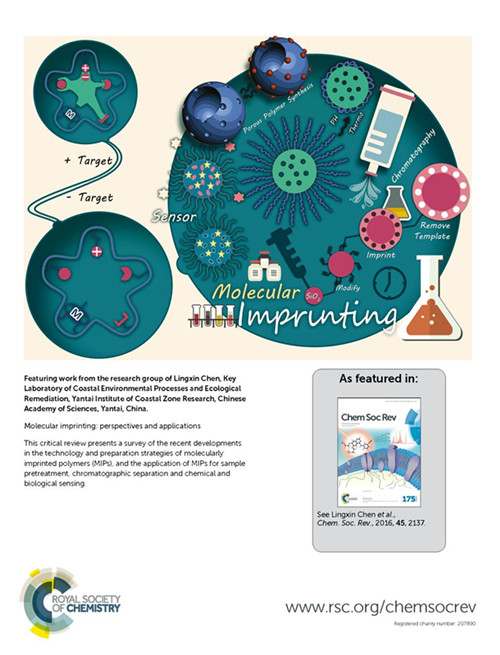A critical review article entitled “Molecular imprinting: perspectives and applications” (Chemical Society Reviews, 2016, 45, 2137–2211) has been published by Chemical Society Reviews recently, the top journal of Royal Society of Chemistry, which was contributed by Professor Lingxin Chen’s group of “Environmental Analysis Theory & Engineering Technology”, from Key Laboratory of Coastal Environmental Processes and Ecological Remediation, Yantai Institute of Coastal Zone Research, Chinese Academy of Sciences (YICCAS). This is the 2nd comprehensive review on molecular imprinting, emphatically focusing on the development in the imprinting field since 2011, following their 1st review entitled “Recent advances in molecular imprinting technology: current status, challenges and highlighted applications” (Chemical Society Reviews, 2011, 40, 2922–2942).
Molecular imprinting technology (MIT) has become a research hotspot, as a technique for creation of molecularly imprinted polymers (MIPs) with tailor-made binding sites complementary to the template molecules in shape, size and functional groups. Owing to the unique features of structure predictability, recognition specificity and application universality, MIPs have attained widespread applications in various fields such as separation/purification, biomimetic sensing, enzyme mimics catalysis, artificial antibody, and environmental analysis/monitoring. Aiming at the recent advances in preparation technologies of MIPs materials, combining with their own related researches and development trends at home and abroad, Prof. Lingxin Chen’s group systematically comprehensively reviewed the recent developments in molecular imprinting including versatile perspectives and applications, concerning novel preparation technologies and strategies of MIT, and highlighting the applications of MIPs. Smart MIT for MIPs is especially highlighted including ingenious MIT (surface imprinting, nanoimprinting, living/controlled radical polymerization, solid-phase synthesis technology, etc.), special strategies of MIT (multi-template imprinting, multi-functional monomer imprinting, dummy imprinting, segment imprinting strategy, etc.) and stimuli-responsive MIT (single/dual/multi-responsive technology). Representative applications of new formatted MIPs for sample pretreatment/chromatographic separation of complicated matrices and chemical/biological sensing analysis are thoroughly surveyed. Finally, future perspectives of molecular imprinting especially technologies fusion and industrial applications prospects are proposed. This critical review can provide excellent guidance for mastering the development trends of molecular imprinting and conducting innovative researches in molecular imprinting.
Currently, Prof. Chen’s group undertakes a number of research projects such as the National Natural Science Foundation of China. Aiming at typical coastal zone environmental pollutants, utilizing nanotechnology, biomaterials and optical/electronic/magnetic tools to fabricate micro/nanoscale analysis/sensing interfaces, his group purposes to develop new analysis/monitoring theories, experimental methods and apparatus equipment with excellent analytical performances of high sensitivity, high selectivity, simplicity and rapidity. The major research orientations include methods development of advanced imaging visualization analysis/monitoring, and environmental samples pretreatment materials, methods and technologies, etc. The group has published a series of innovative research achievements on the respected journals ACS Applied Materials & Interfaces, Analytical Chemistry, Biosensor and Bioelectronics, Biomaterials, Journal of Materials Chemistry A, etc.
